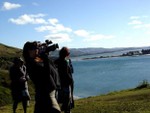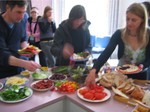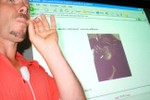- Alison Isadora performing at the Friday Night Launch
- Capturing footage for the Rgb Project.
- Dr Melinda Rackham launching ANAT’s Filter Magazine
- Conference Lunch
- Marcus Williams during the online perfomance ‘The Smoke In’
ADA _emerge_ Symposium
By Su Ballard and Stella Brennan
First Published in Visit Number 8 Summer/Autumn 2006
Aotearoa Digital Arts is New Zealand/Aotearoa’s only digital artists’ network. Instigated in 2003 by Stella Brennan and Sean Cubitt during Brennan’s stint as inaugural Digital Artist in Residence at Waikato University’s Screen and Media Department, ADA has grown to claim a particular place in the local context. ADA was born of the observation that although new media artists were often highly networked in terms of both their own practice and their professional relationships, there was no national organization drawing together those with a common interest in digital art. This recognition suggested the irreversible importance of place against the frictionless communication enabled, in theory, by network technologies.
ADA is a network by the simplest of means: it is open, un-moderated and self-defining. Membership of ADA hovers around 150 people, mostly artists, curators, writers, and teachers with some kind of affiliation to New Zealand. In material terms ADA is an email-discussion list, a website, and three face-to-face symposia: the first at Waikato University, Hamilton, the second at Auckland University of Technology and the most recent, in November 2005, at Otago University in Dunedin.
The 2005 Symposium, emerge, represented a leap forward in structure and complexity. Support from Otago University, Otago Polytechnic School of Art, Artspace Auckland and Creative New Zealand enabled ADA to stage a three-day event with three international guests. Presentations by Steve Dietz (curator of ISEA 2006 in San Jose), Melinda Rackham (director of the Australian Network for Art and Technology) and Anna Munster (senior lecturer at the College of Fine Arts, Sydney, [by proxy due to a last minute illness]) addressed the ongoing development of media arts practice and networks within an international context. Due to specific institutional and funding formations, Australia and the US have far larger and more cohesive new media scenes than New Zealand — although Australia’s recent re-absorption of its dedicated new media fund into the general arts fund was a topic of discussion in Dunedin.
The connection between list discussion and the symposium was emphasised by the opportunity for speakers to present online before the conference, to trial ideas and gain the input of those unable to attend in person. This system of open peer review is one way to address a general dissatisfaction with closed conference formats in which papers are simply ‘read’ and discussion is unformulated and cursory. Presenting abstracts and starters for discussion opened up conversations that continued within the conference rooms. Without pressuring artists to academicise themselves, ADA emerge focused on the formal presentation of artworks and the articulation of practice within a networked environment.
Friday night launched with videos and performance, including new work by Alison Isadora, a New Zealand violinist and composer based in Amsterdam — who used the sympathies between diagnostic ultrasound technologies and her instrument to generate synthetic melodic waves — and Michael Morley, a Dunedin-based musician, who used loops and realtime manipulation of processed sounds to present a gentle wash of noise that moved in and out of focus. Simon Kong, a sound artist and engineer interested in the physiological possibilities of large-scale sound, ended the night with a DJ set specifically designed for the Dunedin Public Art Gallery environment. Accompanying screenings were new video works by Daniel Belton and Good Company, Iain Cheesman, Kim Pieters and Peter Stapleton, Nathan Thompson, Ana Terry, Stella Brennan and Don Hunter.
The following two days were built around four key sessions: Noise and Sound (Zita Joyce, Michael Morley, Simon Kong, Alison Isadora) which saw the launch of Joyce’s interactive radio spectrum map; Digital Encounters (Su Ballard, Ana Terry, Douglas Bagnall, Mark McQuire) in which Bagnall demonstrated his mimetic television, programmed to spontaneously generate episodes of Shortland Street; and Images and Spaces (Brit Bunkley, Stella Brennan, Caro McCaw) in which Bunkley showcased recent explorations in 3D printing. Developing Networks (a panel discussion with Su Ballard, Anna Munster, Steve Dietz and Melinda Rackham) emphasized the continuity rather than disjunction of onsite/online experience and the importance of both local and distributed networks.
Beginning each day were networked performances involving collaborators across the globe. ‘The Proposal in 3 acts’ by Avatar Body Collision (Helen Varley Jamieson and Vicki Smith in Dunedin, Karla Ptacek in London and Leena Saarinen in Finland), had gullible audience members reaching for their institutional checkbooks to fund a grant application written by the performers on the fly. ‘The Smoke In’ presented in Dunedin by Marcus Williams, in conjunction with HOWL festival in Austria (with Dagmar Eberhardt, Monochrom and Mathieu & Molicnik) generated a very real sensation of networked bodily connections through a synchronous cigarette break.
The third piece, R.g.b., by Canadian artist Jacky Sawastsky required active contribution from conference attendees in the creation of networked video. R.g.b invites participants to interact with the environment through the concepts of the RGB-colour space, a representation of colour commonly used by digital technology. Participants travelled to different locations around Dunedin, using video to document one of the three composite colours: Red, Green and Blue. The resulting clips were then input to software written by the artist. The programme examines the footage, highlighting only what it ‘thinks’ is red, green or blue. If it can’t find the specified colour, the original sound of the video-clip is heard. The discrepancy between technology’s standardisation and the individual’s perception of colour underlies the work. Interestingly, in R.g.b.’s first local outing green was found lacking, perhaps because of the software’s northern American bias towards a particular hue – their green may not be the same as our Southern green.
The component footage was uploaded overnight, and the final assembled work was then streamed back by the artist in Canada the following day. A poorly-timed internet outage that necessitated a change of venue (a walk down the road from the university to the Otago Polytechnic Art School) reminded us of the frailty of the network and the potential tenuousness of our connections.
The expansion of conversations around new media affords the opportunity to see ADA emerge as part of an ongoing development of engagements with digital practice in NZ: the recent Re:mote festival, which explicitly dealt with technology both as aid to communication and as enhancer of a sense of distance; the Cultural Futures symposium in Auckland in December, which examined indigenous approaches to new media, and the SCANZ festival and workshops in New Plymouth, occurring in July 2006.
New Media festivals and symposia are frequent events in the northern hemisphere. There’s a circuit and delegates lug their laptops and webcams from country to country. In Aotearoa, such events are a novelty, and we’re still working out how it all fits together. In the absence of a dedicated physical space for development of new media projects, ADA emerge enabled the sharing of practices, and contributed towards a very real sense of a digital media community in New Zealand.
Links:
ADA http://www.aotearoadigitalarts.org.nz 

Australian Network for Art and Technology http://www.anat.org.au/ 

ISEA 2006 http://isea2006.sjsu.edu/remote 

RGB project http://www.jackysawatzky.net/Rgb 

Re:mote festival 2005 http://www.remote.org.nz/ 

Cultural Futures http://culturalfutures.place.net.nz 

SCANZ http://www.scanz.org.nz/ 

Stella, Su and Caroline McCaw organised last year’s ADA emerge.






